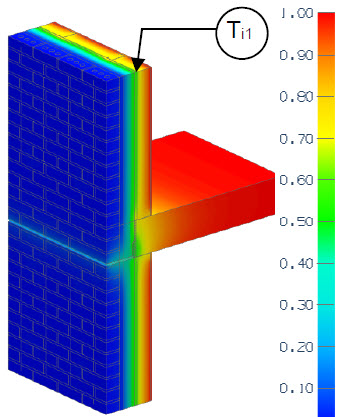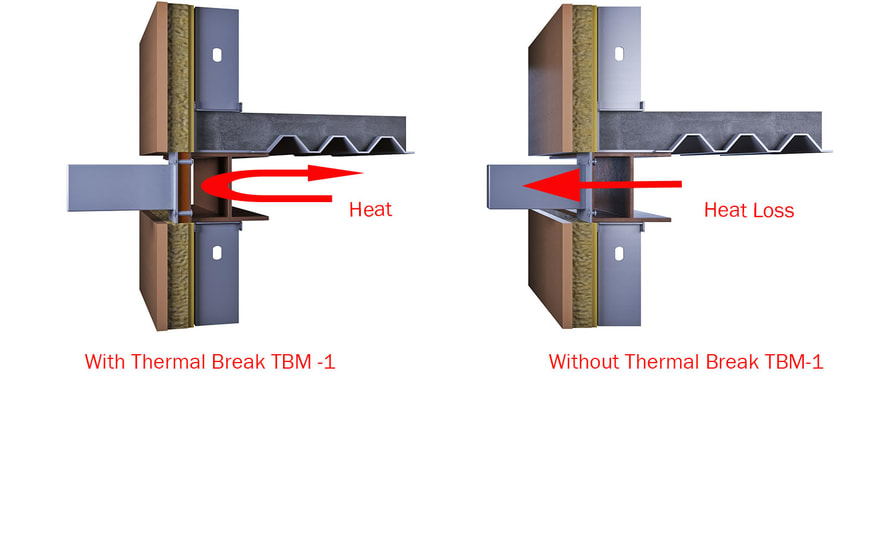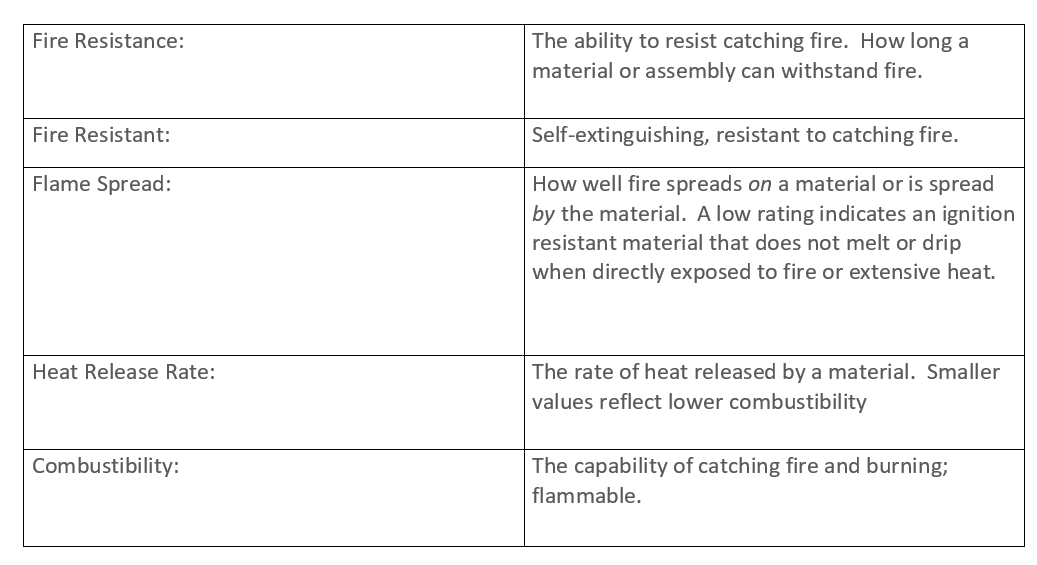Structural Thermal Breaks
Purpose of Thermal Break Materials
Some research has shown that thermal bridges can increase the whole-building conductive heat loss by more than 15%. The percentage is a function of some obvious variables: climate, building type and the location and type of the thermal bridges. The magnitude of the thermal bridging is a large factor. Some interface details increase the U value of a wall by 45%, other transition details increase the U value by only 5%. Is the building enclosure 40% curtain wall? Is there one canopy or are there fifty balconies?
The heat flow (loss) created by thermal bridges varies by the detail and the number of details. If the building design contains lots of poor or inefficient details, the contribution to overall heat loss through the envelope will be high. To improve the energy efficiency of a building, we need to improve the efficiency of the thermal envelope.
If you are designing to Passive House standards, thermal break materials are common in design. Thermal bridges are simply not allowed and air leakage is restricted. This significantly reduces heat loss, which in turn reduces energy consumption. Designing to LEED standards also involves reducing a building’s energy footprint and EA credits are given for optimizing building energy performance, which includes optimizing the efficiency of the thermal envelope.
So thermal bridges have an impact on the thermal envelope, whose performance contributes to the overall building energy costs. How do we reduce the heat loss due to thermal bridging? By using thermal breaks. Thermal breaks create continuity within the thermal control layer which results in true continuous insulation…..
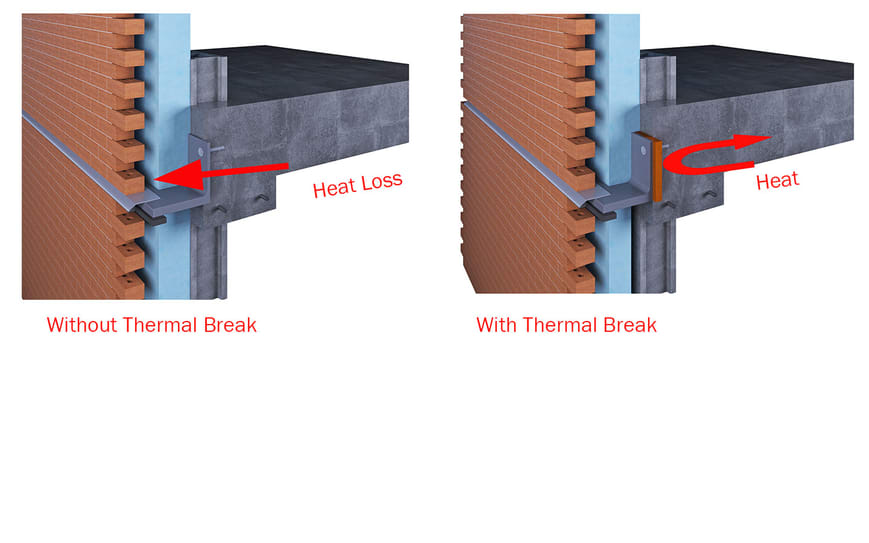

The purpose of thermal break materials and systems (thermal breaks) is to reduce the impact of thermal bridging by preventing conductive heat flow through the thermal envelope. Thermal breaks keep the heat in and push the dew point out. They break the bridge.
Effectiveness of Thermal Break Materials
Con ● duc ● tiv ● i ● ty
/ kän dək tivədē/
noun
The measure of a material’s ability to transfer heat.

Heat Loss
The thermal conductivity of a thermal break material is an important variable in determining the rate at which heat flows through that material. Heat flow also is dependent on area and temperature. Given the same boundary conditions of, temperature difference across two materials, and the same area and thickness, the material with the higher thermal conductivity will transfer heat at a higher rate.
Thermal break materials are characterized either by their thermal conductivity (k) or thermal resistance (R). The two values are related so either value can be calculated from the other. To determine the effectiveness of a thermal break at reducing heat loss, a thermal model should be created of the detail within the building’s wall or roof assembly. The k or R value of all the materials in the assembly are required in the model.
Why is modeling necessary? Two reasons: First, heat does not flow in parallel paths when highly conductive construction materials are combined in an assembly. If it did, we could use simple math and area-weighted averaging to determine heat flow through an assembly. Second, many interface and transition details are complex and involve corners or other features that make it difficult at best to calculate heat flow.

Consider this:
Steel Z girts can occupy perhaps 10% of a buildings’ exterior wall surface. Yet, they can reduce the clear field R value of a wall by as much as 50%.
Balconies on a building can occupy 3% of the exterior wall surface. It has been shown that balconies can be responsible for as much as 30% of the heat loss in a wall assembly.
Area weighting and parallel heat path assumptions will lead you down an inaccurate path…..
Thermal model of a typical masonry facade assembly using a shelf angle at the floor slab. Note the temperature differences at the angle and within the floor slab.
The results of a thermal model will tell you:
• The actual R value and U value of the assembly without a thermal break
• The adjusted or effective R and U values with a thermal break applied
• How much heat loss is due to the thermal bridging detail
• How much the thermal break improves that heat loss
• The surface temperatures of the materials in the assembly which will indicate whether condensation is likely
To be effective, a thermal break has to have a much, much lower thermal conductivity than the material it is “breaking.” Does thickness matter? In short, yes. For all materials, conductance is a function of thickness. Recall, that heat flow is a function of area, temperature and thermal conductivity. Since the conductance of a material is a function of its thickness, both thickness and area are important in heat flow calculations for a thermal break.
In some instances, using a thermal break that is too thin, can have adverse results! Let’s look at a steel beam supporting a balcony. If we “break” the beam where it passes through the thermal envelope to incorporate a thermal break, we probably need to add an end plate on either side of the break in the beam to connect the thermal break. When we do this, we increase the contact surface area of the steel. Without a thermal break, we would be making the heat flow through the beam worse. With a thermal break, we need to acknowledge that the conductance of the thermal break material is a function of its thickness and the heat flow through the now thermally broken connection is a function of that, plus the area of the connection. Too thin and the impact of the thermal break is lost due to the increase in area of the highly conductive steel. Modeling of several thermal break solutions has shown that the thickness should be at least 1” to achieve any significant reduction in heat loss. This of course does vary by application and assembly.
In any connection design using a thermal break, the goal is to find the appropriate thickness/area combination that helps the wall or roof assembly meet the U value requirement based on climate zone and energy code.
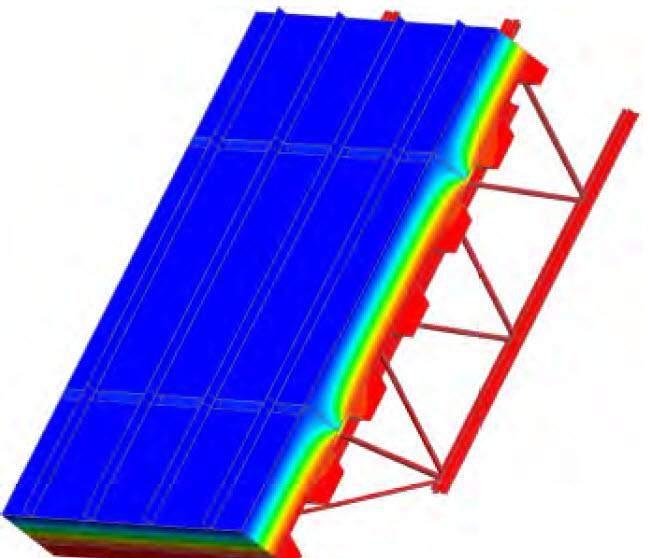
Heat flow associated with steel purlins in a metal building roof. Note the cooler temperatures of the purlin interior surfaces due to thermal bridging.
Condensation
While a properly designed thermal break will considerably reduce heat flow, thermal breaks are also effective at keeping connection surfaces above the dew point. This is particularly important for connection details in buildings where higher than normal relative humidity values exist (hospitals or natatoriums) or in the Southern part of the United States where humidity levels are higher.
A secondary benefit of using a thermal break is to control material surface temperatures. Thermal bridging allows heat from the interior conditioned space to flow out toward the exterior of the enclosure. When the temperature difference is large, interior material surfaces cool. To prevent the potential of condensation forming in the thermal envelope, the surface temperatures of the materials within the envelope must be kept above the dew point temperature. A risk of condensation is possible if thermal bridges that pierce the envelope are not addressed by using a thermal break.
Fire
In addition to preventing heat loss, keeping material surfaces above the dew point and having sufficient strength to maintain the integrity of a structural connection, thermal breaks should also be specified on the basis that they are resistant to burning.
Many thermal break solutions or materials are combustible or contain combustible components. Fire resistance and flame spread are two important characteristics of combustible materials used in buildings. The flammability and subsequent heat release of a material can increase the rate of a fire hazard as well as a fire’s intensity and duration.
Building codes and standards use the following terms to evaluate the differences between combustible materials relative to one another.
Non-combustible materials do not aid combustion or add appreciable heat to a fire; however, combustible materials used in or as thermal breaks should show fire resistance compliance if they are located within a fire-resistance-rated assembly.
Is a fire rating applicable per local building code? Sufficient data should be made available to the building official to show that the required fire resistance rating is not reduced as a result of incorporating a thermal break into the building enclosure. Fire ratings of assemblies may be required per ASTM E119 or NFPA 285 testing depending on the building type and fire code.
The fire properties listed in the table above provide a better understanding of how a material will react in a real fire situation. Each of the characteristics provide different information. They do not include all of the factors required for fire-hazard or fire-risk assessment of materials, products, or assemblies under actual fire conditions. The overall hazard of the thermal break product should be assessed using a combination of tests or data that is appropriate for the end-use application.



